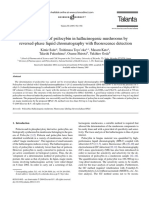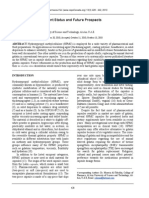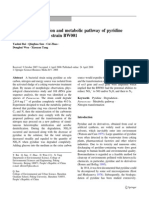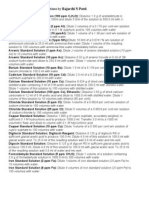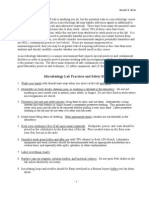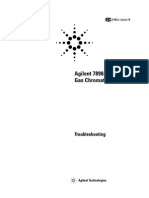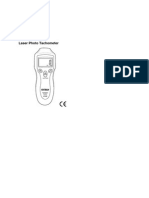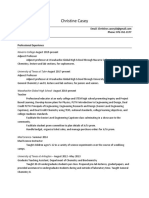Marijuana Testing Method Reference Library
Marijuana Testing Method Reference Library
Uploaded by
dsevolveCopyright:
Available Formats
Marijuana Testing Method Reference Library
Marijuana Testing Method Reference Library
Uploaded by
dsevolveCopyright
Available Formats
Share this document
Did you find this document useful?
Is this content inappropriate?
Copyright:
Available Formats
Marijuana Testing Method Reference Library
Marijuana Testing Method Reference Library
Uploaded by
dsevolveCopyright:
Available Formats
Reference Methods for the Testing of Retail and Medical
Marijuana
Introduction
Cannabis is a novel industry and, currently, no recognized standard methods exist for
the testing of cannabis or cannabis products. The purpose of this document is to
provide guidance to testing facilities on the selection of applicable methodology
pertaining to the testing of retail and medical marijuana/marijuana products. The
methods outlined in this library are applicable by comparative use in areas similar to
the testing of cannabis product; it should not, however, be construed that these
methods are necessarily fit-for-purpose in all aspects of cannabis testing. The
references outlined in this document lack complete validation or matrix extension
specific to cannabis products and thus, require in house laboratory validation prior to
implementation. Any selected methods must be shown as fit-for-purpose through in-
house validation. The potency methods referenced for the analysis of
marijuana/marijuana products are not derived from applicable standard methods as
no proper standard method is available. Any method employed that was not derived
from a standard method must be rigorously tested and validated prior to analysis of
cannabis and cannabis product.
Note: The sources listed in this document are not exhaustive; other methodologies
may be appropriate for use. Due to the constant evolution of scientific analytical
methods, this reference library represents a living document that will be updated as
needed. Marijuana testing facilities are encouraged to consult with the CDPHE
certification program during selection and implementation of testing methodologies.
Microbial Pathogens and Total Yeast and Mold
Concerning the testing of cannabis product for microbiological contaminants, there is
a large pool of standard methods on which to draw. All microbiological methods
employed must include applicable controls. Qualitative pathogen methods must
confirm presumptive results as either positive or negative by the inclusion of a
confirmation step. Confirmation of pathogens should not be addressed by simply re-
running positive sample enrichments or retesting remaining sample.
8100 Lowry Blvd., Denver, CO 80230-6928 P 303-692-3090 www.colorado.gov/cdphe/lab
John W. Hickenlooper, Governor | Larry Wolk, MD, MSPH, Executive Director and Chief Medical Officer
Methods applicable to Salmonella spp. and Shiga toxin-producing Escherichia coli
testing:
Association of Analytical Communities (AOAC) 2016. “Salmonella in Foods,
967.25” http://www.eoma.aoac.org/methods/info.asp?ID=47595
Food and Drug Administration (FDA), 2016. Bacteriological Analytical Manual
(BAM).
http://www.fda.gov/Food/FoodScienceResearch/LaboratoryMethods/ucm2006
949.htm
International Standards Organization (ISO), 2002. “ISO/TS 6579:2002.”
http://www.iso.org/iso/catalogue_detail.htm?csnumber=29315
International Standards Organization (ISO), 2012. “ISO/TS 13136:2012.”
http://www.iso.org/iso/catalogue_detail.htm?csnumber=53328
Salfinger, Yvonne and Tortorello, Mary Lou, 2015. Compendium of Methods for
the Microbiological Examination of Foods, 5th Edition. American Public Health
Association.
United States Department of Agriculture: Food Safety and Inspection Service
(USDA FSIS), 2016. Microbiology Laboratory Guidebook.
http://www.fda.gov/Food/FoodScienceResearch/LaboratoryMethods/ucm2006
949.htm
Methods applicable to total yeast and mold testing:
Association of Analytical Communities (AOAC) 2016. “Yeast and Mold Counts in
Foods, 997.02.” http://www.eoma.aoac.org/methods/info.asp?ID=46847
Food and Drug Administration (FDA), 2016. Bacteriological Analytical Manual
(BAM).
http://www.fda.gov/Food/FoodScienceResearch/LaboratoryMethods/ucm2006
949.htm
Salfinger, Yvonne and Tortorello, Mary Lou, 2015. Compendium of Methods for
the Microbiological Examination of Foods, 5th Edition. American Public Health
Association.
Residual Solvent Testing
Concerning residual solvent testing, there is a large pool of standard methods from
which to draw. All methods employed must include applicable controls.
Methods applicable to residual solvent testing:
American Society for Testing Materials (ASTM), 2016.
https://global.ihs.com/standards.cfm?publisher=ASTM&RID=Z56&MID=ASTM&gc
lid=CJTImMLNosoCFQIHaQodhgoHkQ
Environmental Protection Agency (EPA), 2016. “310B-Residual Solvents.”
http://www3.epa.gov/ttn/emc/methods/method310b.html
Lake, Rick., 2016. “RESTEK Revised USP 467 Residual Solvent Method.”
RESTEK: http://www.restek.com/Technical-Resources/Technical-
Library/Pharmaceutical/pharm_A017
8100 Lowry Blvd., Denver, CO 80230-6928 P 303-692-3090 www.colorado.gov/cdphe/lab
John W. Hickenlooper, Governor | Larry Wolk, MD, MSPH, Executive Director and Chief Medical Officer
United States Pharmacopeia (USP), 2008. “<467> Residual Solvents.”
http://www.usp.org/usp-nf/official-text/accelerated-revision-
process/accelerated-revision-history/general-chapter-organic-volatile
Pesticide Residue Testing
Concerning pesticide testing, there is a large pool of standard methods from which to
draw. All methods employed must include applicable controls.
Methods applicable to pesticide residue testing:
Association of Analytical Communities (AOAC) 2016. “Pesticide Residues in
Foods by Acetonitrile Extraction and Partitioning with Magnesium Sulfate,
2007.01” http://www.eoma.aoac.org/methods/info.asp?ID=48938
Collaborative Validation of the QuEChERS Procedure for the Determination of
Pesticide Residues in Food by LC-MS/MS. J.Agric.Food Chem, 2011,59,6383-
6411.
Determination of Pesticide Residues in Foods by Acetonitrile Extraction and
Partitioning with Magnesium Sulfate: Collaborative Study LEHOTAY: Journal of
AOAC International Vol.90,No.2,2007.
Food and Drug Administration (FDA), 2016: Pesticide Analytical Manual (PAM).
http://www.fda.gov/Food/FoodScienceResearch/LaboratoryMethods/ucm2006
955.htm
International Standards Organization (ISO), 2016.
http://www.iso.org/iso/home.html
United States Department of Agriculture: Food Safety and Inspection Service
(USDA FSIS), 2016. Chemistry Laboratory Guidebook.
http://www.fsis.usda.gov/wps/portal/fsis/topics/science/laboratories-and-
procedures/guidebooks-and-methods/chemistry-laboratory-guidebook
Potency Determination
Concerning potency analysis, while several published methods exist, the available
methods have not been validated to the level of a standard method. The following is a
list of appropriate reference methods. Potency methods must be validated extensively
to ensure they meet the requirements of testing.
Methods applicable to potency determination:
Backer, Benjamin De., et al., 2009. Innovative development and validation of
an HPLC/DAD method for the qualitative and quantitative determination of
major cannabinoids in cannabis plant material. Journal of Chromatography B,
887 4115-4124.
Bovens, Michael., et al., 2009. Recommended method for the identification
and analysis of cannabis and cannabis products: manual for use by National
drug analysis laboratories. United Nations.
https://www.unodc.org/documents/scientific/ST-NAR-40-Ebook.pdf
8100 Lowry Blvd., Denver, CO 80230-6928 P 303-692-3090 www.colorado.gov/cdphe/lab
John W. Hickenlooper, Governor | Larry Wolk, MD, MSPH, Executive Director and Chief Medical Officer
Gambaro, Veniero., et al., 2002. Determination of primary active constituents
in Cannabis preparations by high-resolution gas chromatography/flame
ionoization detection and high-performance liquid chromatography/UV
detection. Analytica Chimica Acta 468, 245-254.
L. Ambach, F. Penitschka, A. Broillet, S. König, W. Weinmann., 2014.
Simultaneous quantification of delta-9-THC, THC-acid A, CBN and CBD in seized
drugs using HPLC-DAD. Forensic Science International 243, 107-111.
Stolker, A.A.M., et al., 2004. Determination of cannabinoids in cannabis
products using liquid chromatography –ion trap mass spectrometry. Journal of
Chromatography A, 1058, 143-151.
Swift, Wendy., et al., 2013. Analysis of Cannabis Seizures in NSW, Australia:
Cannabis Potency and Cannabinoid Profile, PLOS One v.8 i.7 e70052.
Upton, Roy., et al., 2014. Cannabis Inflorescence Cannabis Spp.: Standards of
Identity, Analysis, And Quality Control. American Herbal Pharmacopoeia.
Validation Guidelines
Any method derived from a standard method or literature method requires validation
showing that the method is fit to purpose. In the absence of standard methods, a
single laboratory validation or equivalent is required to show that the method is fit for
purpose in the intended matrix and, if applicable, that any modifications to the
original method do not negatively impact performance. Method validation should, at a
minimum, verify accuracy, precision, analytical sensitivity, analytical specificity, limit
of detection, limit of quantification, reportable range and the identification of
interfering substances. For microbiological methods adopted from a standard method,
inclusivity/exclusivity does not require complete reassessment, provided that the
referenced media, primers, probes, antibodies, critical chemistries, etc., were not
modified.
Association of Analytical Communities (AOAC) 2012. “Methods Committee
Guidelines for Validation of Microbiological Methods for Food and
Environmental Surfaces.” AOAC:
http://www.aoac.org/imis15_prod/AOAC_Docs/StandardsDevelopment/AOAC_
Validation_Guidelines_for_Food_Microbiology-Prepub_version.pdf
Association of Analytical Communities (AOAC) 2002. “Guidelines for Single
Laboratory Validation of Chemical Methods for Dietary Supplements and
Botanicals” AOAC:
http://www.aoac.org/imis15_prod/AOAC_Docs/StandardsDevelopment/SLV_Gu
idelines_Dietary_Supplements.pdf
Food and Drug Administration (FDA) 2015. “Analytical Procedures and Methods
Validation for Drugs and Biologics: Guidance for Industry.” FDA:
http://www.fda.gov/downloads/drugs/guidancecomplianceregulatoryinformati
on/guidances/ucm386366.pdf
Food & Drug Administration Office of Foods and Veterinary Medicine (FDA)
2015. “Guidelines for the Validation of Analytical Methods for the Detection of
Microbial Pathogens in Foods and Feeds 2nd Edition.” FDA:
8100 Lowry Blvd., Denver, CO 80230-6928 P 303-692-3090 www.colorado.gov/cdphe/lab
John W. Hickenlooper, Governor | Larry Wolk, MD, MSPH, Executive Director and Chief Medical Officer
http://www.fda.gov/downloads/ScienceResearch/FieldScience/UCM298730.pd
f
International Conference on Harmonization (ICH) 1996. “Harmonised Tripartite
Guideline Validation of Analytical Procedures: Text and Methodology.” ICH:
http://www.ich.org/fileadmin/Public_Web_Site/ICH_Products/Guidelines/Qua
lity/Q2_R1/Step4/Q2_R1__Guideline.pdf
United States Department of Agriculture Food Safety and Inspection Service
(USDA FSIS) 2010. “Guidance for Test Kit Manufacturers, Laboratories:
Evaluating the Performance of Pathogen Test Kit Methods.” USDA:
http://www.fsis.usda.gov/shared/PDF/Validation_Studies_Pathogen_Detection
_Methods.pdf
8100 Lowry Blvd., Denver, CO 80230-6928 P 303-692-3090 www.colorado.gov/cdphe/lab
John W. Hickenlooper, Governor | Larry Wolk, MD, MSPH, Executive Director and Chief Medical Officer
You might also like
- Determination of Psilocybin in Hallucinogenic Mushrooms by Reversed-Phase Liquid Chromatography With Fluorescence DetectionDocument7 pagesDetermination of Psilocybin in Hallucinogenic Mushrooms by Reversed-Phase Liquid Chromatography With Fluorescence DetectionBen MartinezNo ratings yet
- METHOD of ANALYSIS - Allium Cepae ExtractDocument9 pagesMETHOD of ANALYSIS - Allium Cepae ExtractJames AkibonNo ratings yet
- Mannitol Mannogem Product DescriptionDocument8 pagesMannitol Mannogem Product DescriptionkshleshNo ratings yet
- Determinaton of Sildenafil Citrate and Related Substances in The Commercial Products and Tablet Dosage Form Using HPLCDocument10 pagesDeterminaton of Sildenafil Citrate and Related Substances in The Commercial Products and Tablet Dosage Form Using HPLCAhmad Abdullah Najjar100% (6)
- Operation of Rotary Tablet PressDocument2 pagesOperation of Rotary Tablet PressNorlia Selamat100% (2)
- FPLC Purification HandbookDocument12 pagesFPLC Purification HandbookJoão AlvesNo ratings yet
- 03 030744e PVP Iodine GradesDocument20 pages03 030744e PVP Iodine Gradesdipakrussia0% (1)
- Compliance Program Program: Chapter 56: Drug Quality AssuranceDocument29 pagesCompliance Program Program: Chapter 56: Drug Quality AssuranceMin Thura OoNo ratings yet
- Quinoa Saponins Analysis and Preliminary InvestigationsDocument12 pagesQuinoa Saponins Analysis and Preliminary InvestigationsAndreaPaloCardenasNo ratings yet
- S.L. Jansen Et Al - Melatonin For Cognitive Impairment (Review)Document31 pagesS.L. Jansen Et Al - Melatonin For Cognitive Impairment (Review)LonkesNo ratings yet
- Impurity Profiling of Pharmaceuticals PDFDocument15 pagesImpurity Profiling of Pharmaceuticals PDFsrichainuluNo ratings yet
- Final Protocol SuspensionDocument8 pagesFinal Protocol SuspensionCharleen Joyce UsacdinNo ratings yet
- Anti Microbiological Assay Test or Antibiotic Assay Test of Pharmaceutical Preparation Containing Antibiotics Using 'Cylinder Plate Method'Document4 pagesAnti Microbiological Assay Test or Antibiotic Assay Test of Pharmaceutical Preparation Containing Antibiotics Using 'Cylinder Plate Method'Editor IJTSRDNo ratings yet
- CGMP For Dietary SupplementsDocument11 pagesCGMP For Dietary SupplementsSidhaSaada PatelNo ratings yet
- Reishi MsdsDocument5 pagesReishi MsdsTueNo ratings yet
- USP 467 Residual SolventsDocument16 pagesUSP 467 Residual SolventsputodosNo ratings yet
- Analytical Method ValidationDocument19 pagesAnalytical Method ValidationManasa SgrNo ratings yet
- The New Drug Approval ProcessDocument21 pagesThe New Drug Approval ProcessKasturi PandaNo ratings yet
- Instruction Manual ELISA Kit: 5-Plate FormatDocument16 pagesInstruction Manual ELISA Kit: 5-Plate FormatRangga Raditya Rangga100% (1)
- Factors Affecting Stability of Formulations: Dr. Satish A. Patel M. Pharm, Ph. DDocument38 pagesFactors Affecting Stability of Formulations: Dr. Satish A. Patel M. Pharm, Ph. DMr. HIMANSHU PALIWALNo ratings yet
- Indoor Marijuana Lab Results (Dogwalker & Blackdog)Document8 pagesIndoor Marijuana Lab Results (Dogwalker & Blackdog)Teresa Mahoney100% (1)
- Mixing and Formulation of Low Dose Drugs UnderlyinDocument17 pagesMixing and Formulation of Low Dose Drugs UnderlyincbcalderonNo ratings yet
- Machines Used in Tablet ManufacturingDocument6 pagesMachines Used in Tablet ManufacturingGauthaman KarunakaranNo ratings yet
- Melatonin EU PDFDocument32 pagesMelatonin EU PDFBernat Bertomeu BarralNo ratings yet
- RS Testing Procedure PDFDocument36 pagesRS Testing Procedure PDFsiddhu444No ratings yet
- P Chloro M XylenolDocument2 pagesP Chloro M XylenolJai MurugeshNo ratings yet
- Drug Development PathwayDocument15 pagesDrug Development PathwayYogya sreeharshini MandaliNo ratings yet
- Lab Report SQC7008 ParabensDocument8 pagesLab Report SQC7008 ParabenstamilarasiganasanNo ratings yet
- USP 1086 Impurities in Drug Substances and Drug ProductsDocument3 pagesUSP 1086 Impurities in Drug Substances and Drug ProductsMuhammad JamilNo ratings yet
- Facility DefinitionDocument11 pagesFacility DefinitionMelissa FassbenderNo ratings yet
- HPMC CapsulesDocument15 pagesHPMC Capsuleskunalprabhu148No ratings yet
- HPMC Pittcon 2008Document1 pageHPMC Pittcon 2008Sonet SahaNo ratings yet
- Development of Forced Degradation and Stability Indicating Studies of Drugs-A Review PDFDocument7 pagesDevelopment of Forced Degradation and Stability Indicating Studies of Drugs-A Review PDFtristanprNo ratings yet
- FDA Guidance Polymorphs-ANDAs Ucm072866Document13 pagesFDA Guidance Polymorphs-ANDAs Ucm072866bmartindoyle6396No ratings yet
- Stability Indicating AssayDocument28 pagesStability Indicating AssayJugal Kishore Arya100% (2)
- Aquasomes: A Seminar OnDocument23 pagesAquasomes: A Seminar OnsukanyaNo ratings yet
- PyridineDocument12 pagesPyridineCao Thế AnhNo ratings yet
- 2.2.32 Loss On DryingDocument1 page2.2.32 Loss On DryingMulayam Singh YadavNo ratings yet
- G. Amphray Laboratories: Paracetamol BPDocument2 pagesG. Amphray Laboratories: Paracetamol BPAlhamzah Rachmat FadjarNo ratings yet
- 1 Amino Acid Analysis - Agilent PDFDocument49 pages1 Amino Acid Analysis - Agilent PDFfarkad rawiNo ratings yet
- WHO Information Note: BackgroundDocument4 pagesWHO Information Note: BackgroundRajan MahalingamNo ratings yet
- Validation Protocol SampleDocument4 pagesValidation Protocol SampleAbdelhamid ABDENNOURI100% (1)
- GChandbook2008Document72 pagesGChandbook2008api-19918078No ratings yet
- Pharmaceutical Technology Oct 2021 ApiDocument69 pagesPharmaceutical Technology Oct 2021 ApiChetan dhadhlaNo ratings yet
- Preparation of Sodium Bicarbonate Ear Drops StudentsDocument2 pagesPreparation of Sodium Bicarbonate Ear Drops Studentsluisynon67% (3)
- 〈51〉 ANTIMICROBIAL EFFECTIVENESS TESTINGDocument3 pages〈51〉 ANTIMICROBIAL EFFECTIVENESS TESTINGevct1989No ratings yet
- Preparation of Standard SolutionsDocument2 pagesPreparation of Standard SolutionsRajarshi Patel100% (3)
- Himedia CatalogueDocument1 pageHimedia Catalogueshine aungNo ratings yet
- Limit Test For Heavy MetalsDocument19 pagesLimit Test For Heavy MetalsnutrimakeNo ratings yet
- Microbiology Lab SafetyDocument5 pagesMicrobiology Lab SafetyvpnarashimmanNo ratings yet
- Active Pharmaceutical Ingredients - ListDocument13 pagesActive Pharmaceutical Ingredients - List0921pyNo ratings yet
- Anthocyanidin in Syrup HPLC ValidationDocument14 pagesAnthocyanidin in Syrup HPLC ValidationNaeem MalikNo ratings yet
- 3M Petrifilm Plates Certifications, Recognitions and ValidationsDocument13 pages3M Petrifilm Plates Certifications, Recognitions and ValidationsMaya KiranaNo ratings yet
- Flavonoids From Black Chokeberries, Aronia MelanocarpaDocument8 pagesFlavonoids From Black Chokeberries, Aronia MelanocarpaleewiuNo ratings yet
- Analytical Chemistry 1Document22 pagesAnalytical Chemistry 1Jeremy CalderonNo ratings yet
- 6 ParenteralDocument36 pages6 ParenteralVipin Valappil100% (1)
- Comprehensive Quality by Design for Pharmaceutical Product Development and ManufactureFrom EverandComprehensive Quality by Design for Pharmaceutical Product Development and ManufactureGintaras V. ReklaitisNo ratings yet
- Quality Management Systems A Complete Guide - 2021 EditionFrom EverandQuality Management Systems A Complete Guide - 2021 EditionNo ratings yet
- Chirality in Drug ResearchFrom EverandChirality in Drug ResearchEric FrancotteNo ratings yet
- Generic Drugs Formulation Manual: Basic Principles of New Products DevelopmentFrom EverandGeneric Drugs Formulation Manual: Basic Principles of New Products DevelopmentNo ratings yet
- High-Performance Gradient Elution: The Practical Application of the Linear-Solvent-Strength ModelFrom EverandHigh-Performance Gradient Elution: The Practical Application of the Linear-Solvent-Strength ModelNo ratings yet
- Inspection Observations FY22Document358 pagesInspection Observations FY22dsevolveNo ratings yet
- WP 80078 Chromeleon Cds 21 CFR Part 11 Wp80078 enDocument32 pagesWP 80078 Chromeleon Cds 21 CFR Part 11 Wp80078 endsevolveNo ratings yet
- SupplierQuestionnaire SectionA General Info ModifiedDocument12 pagesSupplierQuestionnaire SectionA General Info ModifieddsevolveNo ratings yet
- VMP GuideDocument6 pagesVMP GuidedsevolveNo ratings yet
- Nero Backitup ManualDocument86 pagesNero Backitup ManualdsevolveNo ratings yet
- Agilent GC 7890A TroubleshootingDocument112 pagesAgilent GC 7890A TroubleshootingdsevolveNo ratings yet
- User's Guide: Model 461920 Laser Photo TachometerDocument5 pagesUser's Guide: Model 461920 Laser Photo TachometerdsevolveNo ratings yet
- 2011 - Rapid Simultaneous Determination of Telmisartan, Amlodipine Besylate and Hydrochlorothiazide in A Combined Poly Pill Dosage Form by Stability-Indicating Ultra Performance Liquid ChromatographyDocument16 pages2011 - Rapid Simultaneous Determination of Telmisartan, Amlodipine Besylate and Hydrochlorothiazide in A Combined Poly Pill Dosage Form by Stability-Indicating Ultra Performance Liquid ChromatographyStefana SzántóNo ratings yet
- The Study of GABA Content and Development of GABA-EnrichedYogurt From Germinated Red Rice (Munpu RiceDocument8 pagesThe Study of GABA Content and Development of GABA-EnrichedYogurt From Germinated Red Rice (Munpu RiceCM APARTELLENo ratings yet
- Chapter 3-EnZYME Production and PURIFICATION 20141009Document58 pagesChapter 3-EnZYME Production and PURIFICATION 20141009Minh Tiến TrầnNo ratings yet
- MS Solutions: Tech TipDocument11 pagesMS Solutions: Tech TipKelumNo ratings yet
- Aplication FS PDFDocument158 pagesAplication FS PDFMartha Isabel Paez MeloNo ratings yet
- 2 PBDocument7 pages2 PBAnaNo ratings yet
- Biomonitoring of 5 Flourouracil - AnyDocument23 pagesBiomonitoring of 5 Flourouracil - AnyAgus TianyNo ratings yet
- M.Pharm Pharmaceutical Analysis R17Document25 pagesM.Pharm Pharmaceutical Analysis R17Haritha hariNo ratings yet
- Lesson 10 Chapter 2Document38 pagesLesson 10 Chapter 2Crisanto PerezNo ratings yet
- Development of Analytical Method and Validation For Simultaneous Estimation of Clobetasol Propionate and Ketoconazole in Pharmaceutical Cream Formulation by RP-HPLC MethodDocument8 pagesDevelopment of Analytical Method and Validation For Simultaneous Estimation of Clobetasol Propionate and Ketoconazole in Pharmaceutical Cream Formulation by RP-HPLC MethodBaru Chandrasekhar RaoNo ratings yet
- Compatibility of Personalized Formulations in CleoDocument14 pagesCompatibility of Personalized Formulations in CleoMaikel Perez NavarroNo ratings yet
- 10.loridon 60 ML SuspensionDocument5 pages10.loridon 60 ML SuspensionShorup GhoshNo ratings yet
- 1.1: Properties of Acrylamide 1.1.1: Physical PropertiesDocument77 pages1.1: Properties of Acrylamide 1.1.1: Physical PropertiesFaryal RahmanNo ratings yet
- 2014 STD Test Fee - Rev2 - Feb 4 2015 PDFDocument17 pages2014 STD Test Fee - Rev2 - Feb 4 2015 PDFDon King EvangelistaNo ratings yet
- 1 s2.0 S2212429224004437 MainDocument11 pages1 s2.0 S2212429224004437 MainMuhammad AriesNo ratings yet
- (Botanica Lithuanica) Effect of External and Internal Factors On Secondary Metabolites Accumulation in St. Johns WorthDocument8 pages(Botanica Lithuanica) Effect of External and Internal Factors On Secondary Metabolites Accumulation in St. Johns WorthAna Paula S MambriNo ratings yet
- Promo HNZ Sigma Aldrich Labware GuideDocument12 pagesPromo HNZ Sigma Aldrich Labware GuideMargaretaSianneNo ratings yet
- Sani A. Ali: Journal of Applied Pharmaceutical Science 01 (08) 2011: 239-243Document8 pagesSani A. Ali: Journal of Applied Pharmaceutical Science 01 (08) 2011: 239-243Moh. Syamsu ZainNo ratings yet
- HPLC Maintenance AgilentDocument4 pagesHPLC Maintenance AgilentSAN912No ratings yet
- Tips and Tricks of HPLC Separation PDFDocument47 pagesTips and Tricks of HPLC Separation PDFFls Fernando Fls LopesNo ratings yet
- Jurnal Bioekivalensi PDFDocument7 pagesJurnal Bioekivalensi PDFMreyhan SaidNo ratings yet
- Novel ChromatographicDocument11 pagesNovel ChromatographicnatarajantexNo ratings yet
- Pita Calvo2017Document58 pagesPita Calvo2017Xanh XanhNo ratings yet
- 1 s2.0 S0021967301882534 MainDocument4 pages1 s2.0 S0021967301882534 MainAly MohamedNo ratings yet
- Quercetin Level in Stem and Flower Extracts of Clitoria Ternatea and Its Antidermatophytic PotentialDocument9 pagesQuercetin Level in Stem and Flower Extracts of Clitoria Ternatea and Its Antidermatophytic PotentialRaja LakshmiNo ratings yet
- Nurjanah 2020 IOP Conf. Ser. - Earth Environ. Sci. 404 012074Document11 pagesNurjanah 2020 IOP Conf. Ser. - Earth Environ. Sci. 404 012074danangNo ratings yet
- Christine Casey CVDocument4 pagesChristine Casey CVapi-597001473No ratings yet
- Validated Method For Quality Assessment of Henna (Lawsonia Inermis L.) Leaves After Postharvest Blanching and Its Cosmetic ApplicationDocument10 pagesValidated Method For Quality Assessment of Henna (Lawsonia Inermis L.) Leaves After Postharvest Blanching and Its Cosmetic ApplicationTuấn Nguyen AnhNo ratings yet
